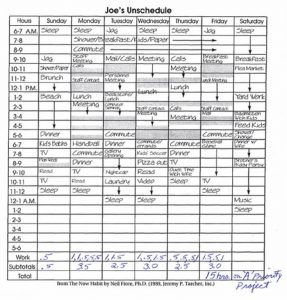There are a lot of time management systems out there. Depending on your own work style and personality, some will work, some won’t.
Recently, I came across a time management tool in the book The Now Habit, by Dr. Neil Fiore. This productivity tool is called the Unschedule.
Now, before I tell you exactly what the Unschedule is, it’s helpful to understand where Dr. Fiore is coming from.
Contrary to popular belief, he doesn’t think the cause of procrastination is laziness.
The cause is much deeper than that.
According to Dr. Fiore:
Procrastination is a mechanism for coping with the anxiety associated with starting or completing any task or decision.
This anxiety comes from many factors that can include fear of failure, perfectionism, fear of success, and low self-confidence.
What’s more, our society has a view that work should be something that is hard, and play is just a waste of time — making work something that is resented and tortuous.
The Unschedule gets down to the source of these issues and provides an effective solution. One that will make you a more successful, more prolific writer that gets the job done every single time.
How Does the Unschedule Work?
Instead of scheduling work you feel you HAVE to do… you plan for all the things you WANT to do. The things you consider fun.
Maybe it’s going to the movies. Spending time with family. Playing a round of golf. Whatever. You get to decide.
Once you’ve scheduled your play activities, schedule other non-work activities, like eating, getting ready for work, going to the grocery store, sleeping, etc.
Now you’ll have a realistic assessment of how many actual hours of work are available to you every day.
As you go throughout your day, work during one of these open hours, for no more than 30 minutes at first. Remember, you’re a procrastinator, so you’re trying to build up your productivity muscle. Anything more than 30 minutes may be too overwhelming to start.
Once those 30 minutes are up, THEN you record the work you did and at what time on your Unschedule.
Immediately follow each work session with a reward… no matter how small or trivial.
At the end of the week, you’ll be able to see how much quality work you actually put in.
Plan Your Unschedule
To help you understand the Unschedule further, here are five of Dr. Fiore’s rules to successfully using your Unschedule to become a more productive, happier you:
1. Fill in your Unschedule with as many non-work activities as possible.
This might include:
- Eating breakfast, lunch, dinner
- Free time, recreation, leisure reading
- Spending time with friends and family
- Exercise
- Routine events like commuting to work, medical appointments, classes, etc.
2. Take credit ONLY for periods of work that represent at least 30 minutes of uninterrupted work.
After every 30-minute work session, record it on your Unschedule. This half hour of work represents quality work, not trips to get potato chips or calls to a friend.
3. Reward yourself with a break or enjoyable activity after every period worked.
You deserve it. After all, you got started! By rewarding yourself, you create a positive association that will soon become a great work habit.
4. Keep track of how many quality hours you’ve worked per day and per week.
This emphasizes what you did accomplish throughout the day and throughout the week. This keeps you focusing on the positive, keeping the momentum towards efficiency and productivity.
5. Allow at least one full day a week for recreation and small chores.
On this day, you are not to work at all. Instead, have fun. Doing this will re-energize you, making you more productive and effective when you get back to work.
Here is an example of an Unschedule in action:
In this sample Unschedule, the shaded areas represent the hours Joe worked at least 30 minutes on a very important work project. Then each day, he totaled the hours worked, and came up with a cumulative total at the end of the week.
The Unschedule uses behavioral science to get you to become the kind of person that starts projects and gets them done.
By recording your progress, you get a visual of what you’ve accomplished and notice any patterns where you are using your time ineffectively, or simply procrastinating.







